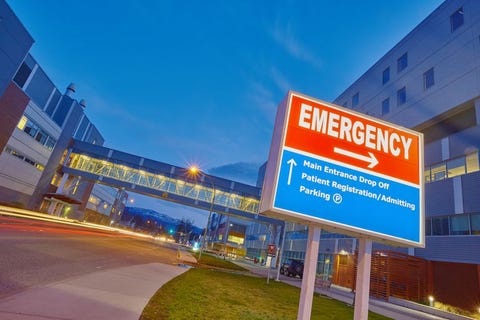Can You Go to Urgent Care for Gallbladder Pain
Aches and pains and colds and "having one of those days" are things we all have to suffer through from time to time, but not all ailments are created equal. When you think you broke something or you're concerned about a funky rash (and your home remedy of "Found in the Medicine Cabinet Soup" isn't cutting it), your instinct might be to run to the emergency room.
But as it turns out, a visit to an urgent care facility is often all you need. Whereas emergency departments exist to provide immediate care to patients without appointments (who are often arriving by ambulance), urgent care centers can treat a broad spectrum of conditions, particularly those not serious enough to warrant a trip to the emergency room.
Basically, if you can walk and talk and have an idea of what might be wrong (you tweaked a hammy at pickup last night), you can skip the ER, says Jason Roth, M.D., medical director of the emergency department at St. Anthony Hospital in Lakewood, CO.
You should also start with urgent care if cost is a concern; the average visit will run you about $170, as opposed to, say, $2,000 at the ER.
Of course, more serious concerns like heavy bleeding, chest pain, weakness, and head injuries warrant a trip to the ER.
So that you don't have to decide in the moment, we've compiled this guide to help you choose between urgent care and the ER when 10 common ailments strike.

Milkos Getty Images
1. You have a headache...
Figuring out where to bring your headache largely comes down to knowing what's typical, says Roth. Does the headache feel like something you've had before but a little more bothersome? Do you get migraines? Urgent care is likely fine.
If your headache comes on rapidly and quickly peaks in intensity, head to the ER. Doctors worry about issues like bleeding in the brain or, if you also have a fever and neck pain, infections like meningitis, Roth says.
2. You have a toothache…
What's worse than an aching jaw or a cracked tooth? Arriving at a busy ER waiting room only to be told to turn around. A toothache is the fifth most common reason for an ER visit, yet nearly 79 percent of patients would have been better off if they'd gone to the dentist instead.
If you can't get to the dentist, says Roth, most urgent care centers can handle dental issues by way of antibiotics. If you're having any trouble breathing or swallowing (due to swelling from your tooth pain), that's ER time.
3. You have a fever...
Fever is one of those symptoms that can be tough to figure out. If you're burning up with cold-like symptoms (and, by the way, everyone else in the family is sick), urgent care or even a virtual visit with a doc is probably fine. If your fever also comes with lightheadedness, trouble breathing, or serious abdominal pain, Roth says to play it safe and go to the ER.

doranjclark Getty Images
4. You threw up...
Eat something wonky? Know someone with norovirus? If you can identify the likely source of your nausea, an urgent care visit should suffice (and you can likely get the meds you need to feel better), says Roth. But if you're seriously lacking fluids (a risk for dehydration), can't keep down food or water, are vomiting blood, or you just think your symptoms seem more extreme, make a trip to the emergency room.
5. You have stomach pain...
Belly pain can be hard to ID, in part because it often takes some time to manifest, says Roth. An example: Appendicitis can start with generalized aches and pains all over and then move down to the right lower abdomen area and hurt more when you move around. General stomachaches can usually be treated by a virtual or urgent care visit, as can migraines if you get them regularly and notice they frequently come with abdominal pain.
Anything new or pain that's worsening should likely be checked out at an ER, says Roth. Pain in the right upper abdomen, especially after you eat, could point to a gallbladder issue, he notes, while severe pain that radiates to the back could be kidney stones. Though these issues are not likely life-threatening, you might need more advanced care and evaluation from an ER.
6. You have chest pain…
First, it's important to know the signs of a heart attack: any discomfort in the center of your chest (crushing pain, pressure, or fullness); pain that spreads from your chest to the arms, jaw, teeth, back, shoulder, neck, or stomach; or breaking out in a cold sweat, fainting, or feeling dizzy.
Heart disease is the leading cause of death for both men and woman, and if you have risk factors for it — being over 55, high blood pressure, high cholesterol, you're a smoker, diabetic, overweight, inactive, or have a family history — you're even more susceptible.
If you notice any alarming chest pain-like symptoms you think could point to a heart attack, visit the ER for blood tests, work-ups, and access to specialists. This is particularly true if your pain is exertional, meaning it comes on with any kind of physical work and feels a bit better at rest, says Roth.
Able to ID some kind of trauma — you fell on your last one-rep max attempt — and now it hurts when you breathe? Chest pain that's likely related to muscular causes can be handled at urgent care centers, says Roth. Again, this is one symptom where you're better safe than sorry, so if you're questioning it, choose the ER.

Hinterhaus Productions Getty Images
7. You think you broke or tweaked something...
Where you should go depends on what the "what" is. In short: Minor broken bones (e.g., your finger) would be a case for urgent care, while major broken bones should be treated at the ER.
Here's another way to decide: rolled your ankle and think it might be broken or sprained, but it doesn't look deformed? Small breaks like that, which won't require straightening of the bone, can be splinted in urgent care centers, says Roth. If that ankle is flopping around or visibly deformed, seek emergency care.
8. You're cut, bruised, or burned...
This one is fairly simple, but it really comes down to whether or not the issue can be categorized as minor (a cut from cooking that's stopped bleeding but needs some treatment) or major (heavy bleeding, large, open wounds, or any signs that you'd be at risk for losing a limb). This should be obvious, but only the latter requires the attention of an emergency department.
9. You have a rash...
Most of the time, it's fine to take a skin reaction to urgent care. If it comes with more severe symptoms like a fever, choose the ER. That's not a blanket statement, Roth notes, but he says that a fever could suggest a more systemic, full-body reaction or infection that could quickly become dangerous. For example, purple-ish dots on the skin definitely call for the emergency room; these could be inflamed or burst blood vessels under the skin.
10. You have a foreign body in your body…
That depends on where the object is, says Roth. If it's a splinter or your kid stuck something in his nose, you're likely safe at urgent care. But if you swallowed something or, uh, sat on something, you're likely better off at the ER, as you might require surgery or sedation for removal. Hey, at least you'll get a great story out of it.
Cassie Shortsleeve Freelance Writer Cassie Shortsleeve is a skilled freelance writer and editor with almost a decade of experience reporting on all things health, fitness, and travel.
This content is created and maintained by a third party, and imported onto this page to help users provide their email addresses. You may be able to find more information about this and similar content at piano.io
Can You Go to Urgent Care for Gallbladder Pain
Source: https://www.menshealth.com/health/a26446709/should-you-go-to-er-or-urgent-care/
0 Response to "Can You Go to Urgent Care for Gallbladder Pain"
Post a Comment